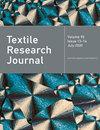人体生理汗液和预湿法对辐射照射下热防护服传热传质效果的比较
IF 1.9
4区 工程技术
Q2 MATERIALS SCIENCE, TEXTILES
引用次数: 0
摘要
本研究对人体出汗行为进行了深入调查,以确保准确评估服装的热防护性能,解决现有标准化方法不足的问题。研究人员比较了三种面料在辐射照射下的不同出汗率,重点探索了传统预湿法和创新连续出汗法的热量和质量传递机制。结果发现,预湿法在织物出现瞬时吸湿的情况下非常有效,而连续出汗法在饱和前需要持续供湿的情况下表现出色,并可用于估算液体水分传递。特别是对于吸湿性低的材料,与连续出汗法相比,预湿法在出汗率为 10 μL/min/cm2 的情况下,皮肤表面吸收的热能要多 86.24 kJ/m2,这突出表明预湿法有高估热防护性能的倾向。相反,对于吸湿性较强的织物和出汗率较高的测试,采用连续出汗法代替预湿法时,皮肤表面吸收的热能减少了 32.81%,大大降低了操作风险。这项研究为根据特定环境条件选择合适的出汗模拟方法来评估热防护性能提供了宝贵的指导,并为进一步研究热量和湿气的传递提供了重要的启示。本文章由计算机程序翻译,如有差异,请以英文原文为准。
Comparison between the human physiological sweat and pre-wetting method on the heat and mass transfer of thermal protective clothing under radiant exposure
In this study, a thorough investigation of human sweating behavior was conducted to ensure an accurate evaluation of the thermal protection performance of garments, addressing the lack of existing standardized methods. Three fabrics were compared at different sweating rates under radiant exposure, focusing on exploring heat and mass transfer mechanisms using the traditional pre-wetting method and the innovative continuous sweating method. It was found that the pre-wetting method was effective in situations where fabrics experienced transient moisture absorption, whereas the continuous sweating method excelled in scenarios requiring continuous moisture supply before saturation and was used to estimate liquid moisture transfer. In particular, for materials with low hygroscopicity, the pre-wetting method resulted in 86.24 kJ/m2 more absorbed thermal energy at the skin surface compared with the continuous sweating method, with a sweat rate of 10 μL/min/cm2 , highlighting the tendency of the pre-wetting method to overestimate the thermal protective performance. Conversely, for fabrics with high hygroscopicity and testing with high sweat rate, a 32.81% reduction in absorbed thermal energy on the skin surface was observed when the continuous sweating method was used in place of the pre-wetting method, significantly reducing operational risks. This study provides valuable guidance in selecting appropriate sweat simulation methods to evaluate the thermal protection performance based on specific environmental conditions, and provides critical insights for further studies on heat and moisture transfer.
求助全文
通过发布文献求助,成功后即可免费获取论文全文。
去求助
来源期刊

Textile Research Journal
工程技术-材料科学:纺织
CiteScore
4.00
自引率
21.70%
发文量
309
审稿时长
1.5 months
期刊介绍:
The Textile Research Journal is the leading peer reviewed Journal for textile research. It is devoted to the dissemination of fundamental, theoretical and applied scientific knowledge in materials, chemistry, manufacture and system sciences related to fibers, fibrous assemblies and textiles. The Journal serves authors and subscribers worldwide, and it is selective in accepting contributions on the basis of merit, novelty and originality.
 求助内容:
求助内容: 应助结果提醒方式:
应助结果提醒方式:


